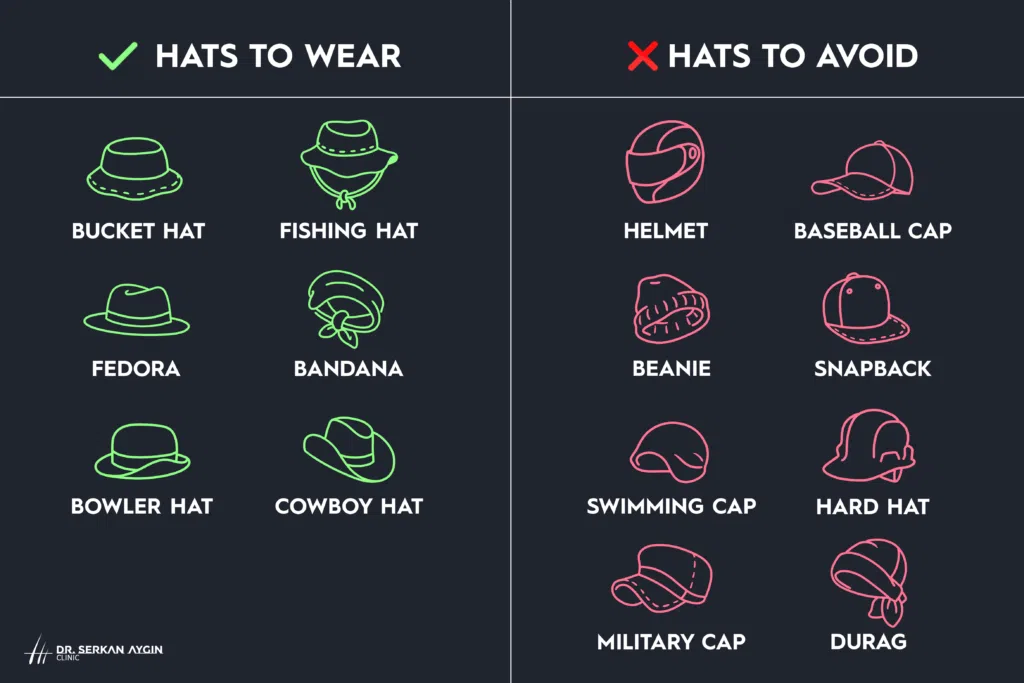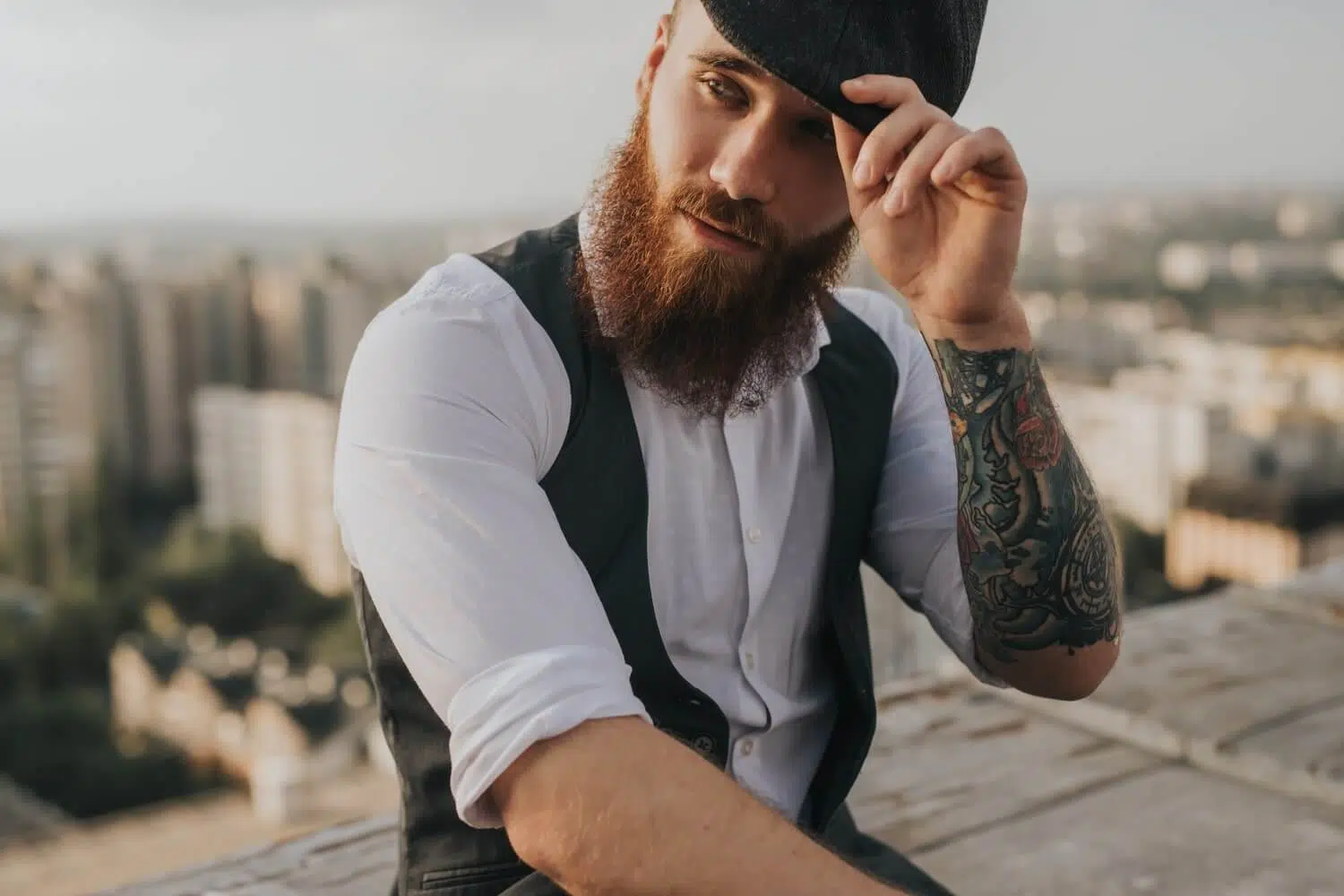There are many ways to cover your head after a hair transplant, such as wearing a loose-fitting bucket hat or putting a bandana on. It’s easier to protect your newly gained hair from environmental elements than you think.
We understand the need to learn how to cover your head after a hair transplant, as walking around with incisions isn’t ideal for the majority of our patients. Learning how to cover the head helps prevent damage to the scalp and hides the evidence of hair transplant at the same time.
In this article, we will give you information on wearing hats after a hair transplant, how long after a hair transplant you can wear a hat and more. To summarize:
- YOU SHOULD WAIT 7-14 DAYS BEFORE WEARING ANY HEAD COVERINGS.
- THE MATERIAL AND FIT OF THE HEADGEAR YOU WANT TO WEAR ARE CRUCIAL IN DETERMINING WHEN YOU CAN WEAR IT.
- MAKE SURE TO CHOOSE BREATHABLE, SOFT, AND LIGHT HATS TO AVOID DAMAGING YOUR HAIR GRAFTS.
- PRACTICE HEADWEAR CARE SUCH AS PUTTING THE HAT ON WITH BOTH HANDS AND CLEANING THE HAT REGULARLY.
Read on to prepare your hair and your hat arsenal for what’s to come.
10 Tips On How To Cover Head After Hair Transplant
- PREFER LOOSE-FITTING HATS SUCH AS BUCKET HATS OR FISHING HATS.
- MAKE SURE THAT THE HAT IS PLACED GENTLY IN A WAY THAT COVERS THE ENTIRETY OF YOUR SCALP.
- CHOOSE HEADPIECES MADE FROM SMOOTH MATERIALS SUCH AS SILK, SATIN, LINEN, OR MODAL.
- AVOID THICKLY WOVEN FABRICS THAT MIGHT PULL ON SENSITIVE GRAFTS SUCH AS COTTON AND WOOL.
- ONLY CHOOSE BREATHABLE FABRICS SO THAT YOUR SCALP CAN GET ENOUGH AIRFLOW.
- DON’T WEAR HATS FOR LONGER THAN 3-4 HOURS. WEARING HATS DURING THE COMMUTE IS FINE.
- IF THE HAT IS CAUSING YOUR SCALP TO HEAT UP AND SWEAT, TRY TO STAY INDOORS SO AS TO NOT WEAR A HAT.
- CLEAN YOUR HEADWEAR THOROUGHLY TO AVOID THE RISK OF INFECTION.
- USE BOTH HANDS TO FIND AN ANGLE WHILE PUTTING ON AND TAKING OFF YOUR HAT TO ELIMINATE FRICTION.
- WAIT AT LEAST A MONTH BEFORE PUTTING ON HEAVY HEADWEAR SUCH AS MOTORCYCLE HELMETS OR HARD HATS.
Can You Cover Your Head After A Hair Transplant?
Yes, you can cover your head, but you have to be patient and hold yourself back for 2 weeks for your follicular grafts to become firmly rooted in your scalp.
Although you will be wearing medical dressing or bandages for the first days, you should be careful not to dislodge, move, or hurt the follicles throughout the initial recovery process.
Still, as you continue your life normally after hair transplant surgery, you might need to protect your hair grafts from environmental elements such as sun, wind, and rain.
What Is The Best Head Cover After A Hair Transplant?
The best head cover after a hair transplant is a fisher’s hat or bucket hat. Since fisher’s hat can stay on top of your head without touching the donor or recipient areas, it’s the perfect protection for your delicate post-surgery scalp.
There aren’t specific hats for postop or hair transplant care hats. You can use any loose-fitting hat that protects your hair follicles from environmental factors such as sun and rain during your healing process.
What Are The Other Postop Head Cover Options?
- FISHING HATS
- BUCKET HATS
- BANDANAS
- FEDORAS
- COWBOY HATS
- BOWLER HATS
Hats To Avoid After Hair Transplant
- BASEBALL CAPS
- MOTORCYCLE HELMETS
- BIKE HELMETS
- BEANIES
- SNAPBACKS
- SWIMMING CAPS
- DURAGS
- MILITARY CAPS
- STRAW HATS
The hats and caps you can’t wear after a hair transplant share common characteristics: They are either tight, made of non-breathable materials, or heavy. Take this as a north star while searching for accessories to cover your head after hair transplant surgery.
Suitable Head Coverings For Different Recovery Stages
- 1-5 Days: Don’t wear any head coverings and let your scars breathe to ensure faster healing. Avoid direct sunlight.
- 5-10 Days: You can start wearing very loose-fitting headwear, like fishing hats. Still, it’s best to avoid wearing anything on your head if possible.
- 10-14 Days: You can wear other types of hats, except for helmets.
- 15+ Days: From this point on, you can show off your fashion skills! But make sure to use caution while putting on heavy or tight-fitting headpieces such as helmets or swimming caps.
- 1 Month: Those who have followed the surgeon’s aftercare and shampoo instructions will see that their grafts have rooted strongly into the scalp. They can wear whatever their heart desires from this point on!
How Long After A Hair Transplant Can You Wear A Hat?
You should wait 7-14 days for hair grafts to strongly hold onto the scalp before wearing any head coverings, such as hats. Wearing a head covering before that can dislodge, or hurt hair grafts.
However, there are exceptions, as the duration varies from patient to patient:
-Patients who have extensive scarring may prefer to leave all headgear aside for 14 days.
-Patients who want to do their best hijabs or baseball caps should wait 14 days.
You might need to wear head coverings earlier than 2 weeks. In this case, your hair transplant surgeon will give you instructions on the proper way of putting on a hat without hurting your grafts.
Is It Safe To Wear A Hat After A Hair Transplant?
Yes, as long as you avoid tight headwear that causes friction on the donor and recipient areas it’s safe to wear hats after a hair transplant. If you have to go out while it’s sunny, rainy, or snowy, use caution and wear a hat to avoid putting your hair follicles at risk.
Here’s a master table to check which hats are safe to wear after a hair transplant:

Are Head Scarves Okay To Wear After Hair Transplant?
Yes, after 3-5 days you can wear headscarves after a hair transplant as long as the headscarf is:
- LIGHTLY PLACED IN A DOME-LIKE SHAPE OVER YOUR HEAD
- MADE OF BREATHABLE AND SMOOTH FABRICS.
Are Winter Hats Okay To Wear Over Hair Transplant?
No, it’s not safe to wear winter hats directly after a hair transplant procedure as these types of headwear are made from fabrics that are not breathable. Fabrics such as wool can also tug on the transplanted hair follicles and cause them to dislodge.
You should wait at least 2-3 weeks before wearing these types of headpieces.
Can I Wear Durags Over Hair Transplant?
No, you should avoid wearing durags for at least 14 days after hair transplant surgery. Even though most durags are made of soft fabrics such as silk, they are tight on the scalp and may cause further scarring.
Can I Wear A Hijab After A Hair Transplant?
It’s best to avoid wearing a hijab for 2 weeks after hair transplant no to pressure on the hair grafts.
When you’re cleared to wear a hijab again, make sure to use breathable, soft fabrics that won’t tug on the hair. Do not tie the hijab too tightly, as this might decrease the survival rate of hair follicles.
There are some hairstyles to avoid after a female hair transplant, such as hair extensions, or braids. Make sure that you follow aftercare instructions carefully.
Are Turbans Okay To Wear After Hair Transplant?
No, you should wait at least 2 weeks after hair transplant surgery to wear turbans. When your hair specialist gives you the green light to wear turbans, follow the same rules that apply to hats:
- WRAP YOUR TURBAN LIGHTLY TO NOT DISTURB THE FOLLICULAR GRAFTS
- PREFER TURBANS MADE OF LIGHTER OR BREATHABLE MATERIALS
- DON’T WEAR TURBANS FOR MORE THAN 5 HOURS, LET YOUR SCALP BREATHE
Are Kippahs Or Yarmulkes Okay To Wear After A Hair Transplant?
No, you shouldn’t wear kippahs or yarmulkes directly after the hair transplant surgery.
The majority of hair transplants are conducted by gathering hair follicles from the donor area and implanting them to the vertex, the highest point of the head. Kippahs or yarmulkes sit directly on top of the vertex, thus, they have a high possibility of damaging the newly transplanted hairs.
Covering Your Head For Sun Exposure After Hair Transplant
After the hair transplantation, the scar tissue on your scalp will become unable to defend itself against the harmful UVA and UVB rays of the sun. Protecting the hair follicles becomes your task. What you can do is:
- AVOID DIRECT SUN EXPOSURE FOR 7-14 DAYS AFTER HAIR TRANSPLANT
- DO NOT STAY IN THE SUN FOR EXTENDED PERIODS OR DURING NOON
- USE SPF 50+ SUNSCREEN FOR SENSITIVE SKIN WHEN YOU GO OUTSIDE
- UTILIZE DIFFERENT HATS OR HEAD COVERS
- GET YOURSELF A PARASOL OR AN UMBRELLA IF NECESSARY
REFERENCES
Saad, Sarra et al. “Inflammatory complications after hair transplantation: Report of 10 cases.” Journal of cosmetic dermatology vol. 21,11 (2022): 5938-5941. doi:10.1111/jocd.15244
Patwardhan N, Mysore V; IADVL Dermatosurgery Task Force. Hair transplantation: standard guidelines of care. Indian J Dermatol Venereol Leprol. 2008 Jan;74 Suppl:S46-53. PMID: 18688103.
Nadimi, Sahar. “Complications with Hair Transplantation.” Facial plastic surgery clinics of North America vol. 28,2 (2020): 225-235. doi:10.1016/j.fsc.2020.01.003
Konior, Raymond J, and Cam Simmons. “Patient selection, candidacy, and treatment planning for hair restoration surgery.” Facial plastic surgery clinics of North America vol. 21,3 (2013): 343-50. doi:10.1016/j.fsc.2013.04.004
Kerure, Amit S, and Narendra Patwardhan. “Complications in Hair Transplantation.” Journal of cutaneous and aesthetic surgery vol. 11,4 (2018): 182-189. doi:10.4103/JCAS.JCAS_125_18

